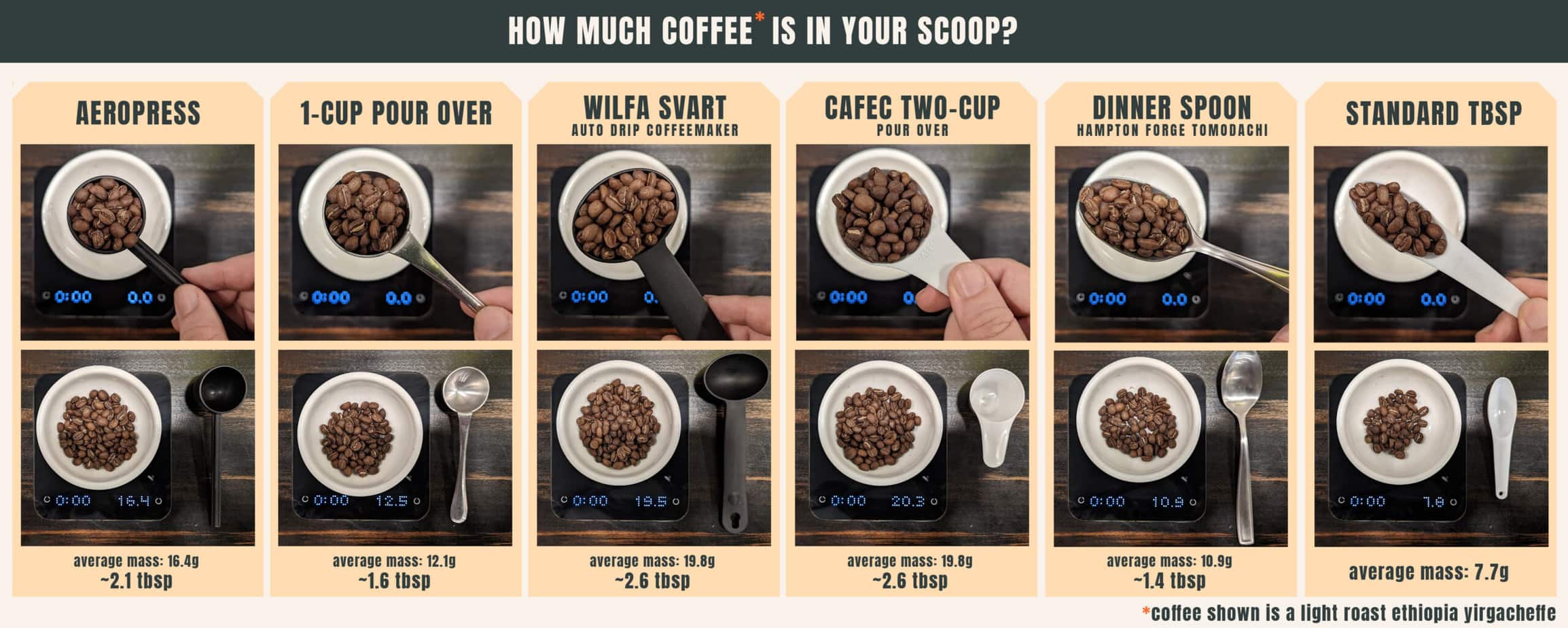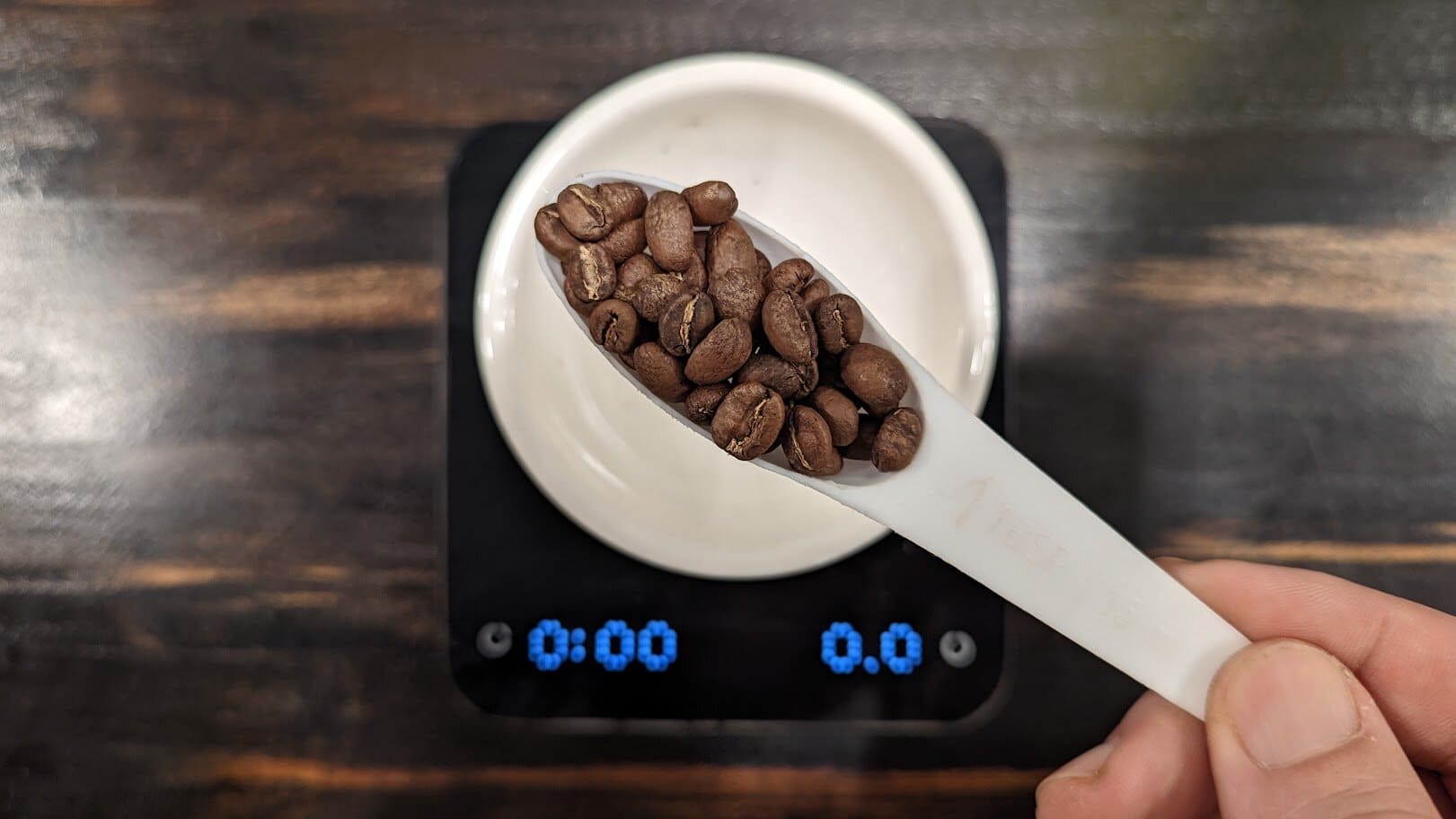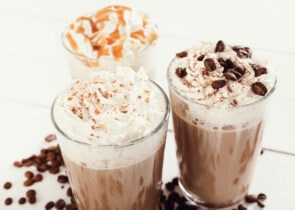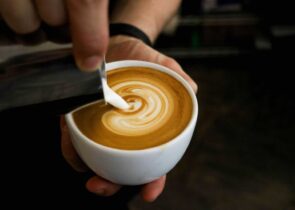So you’ve taken the plunge with some equipment to brew coffee at home. The next step would be to look for a recipe. But one look online, and it’s clear that there’s going to be a bit of a learning curve.
This is the reason businesses come to coffee consultants like me, to help set up their cafe or brew bar. I develop brew recipes for a variety of coffee brewers, meant to suit a client’s requirement or taste preference.
Much of my work involves tinkering around with coffee-to-water ratios, so I know first-hand how difficult this can be. But that’s why you’re here. We’ve done the math so you don’t have to!

Coffee to Water Calculator
Here’s a quick calculator we created to make the process really simple. All you have to do is pick the following: your brewer of choice, how much coffee you want, and how strong you want it.
We’ve created brew strength presets for every method that will provide a good starting point. If you want to skip our recommendations and play around with your own ratios, you can do that as well.
One last step — tell our calculator your favored way to measure coffee and water. The result? A brew recipe that’s tailor-fit to your preferences!
Set your preferred brew strength by choosing from the preset ratios below, or create a custom ratio.
CALCULATING



Why Are Coffee-to-Water Ratios Important?
Coffee-to-water ratios, or brew ratios, are the backbone of every brewing recipe. This concept allows you to easily tweak the intensity of your cup by adding or reducing the amount of coffee that you use — or the amount of water sometimes.
The brew strength presets on our calculator are based on industry standards, popular recipes, and our very own testing. But you don’t have to limit yourself to these! Differences in coffee, equipment, and taste preferences mean that there’s plenty of room to play around.
If you’re eager to know how we arrived at our default ratios for what we consider regular-strength coffee, read on.
Automatic Drip Machine – 1:16.67 Ratio
The ideal brew ratio for drip coffee according to the SCAE (Specialty Coffee Association of Europe) is 60 grams of coffee to 1000 grams (or ml, same thing) of water. More succinctly, 1:16.67.
The SCAE has since merged with the SCA, and brew standards have changed. Still, the aforementioned ratio has remained popular with baristas and coffee trainers thanks to more perceptible flavors compared to the latter organization’s Golden Cup Standard of 1:18.
For automatic drip machines that are meant to be fool-proof appliances, the 1:16.67 ratio is a great choice that will either make you a good cup or at least get you close enough!
Pour Over – 1:16.67 Ratio
Pour-over brewers work the same way as an auto-drip machine, except you heat and pour water onto the ground coffee yourself. The manual aspect offers more variability and control, which can lead to some seriously delicious results.
Whenever I need to brew a coffee I’ve never tried before, I revert to the 1:16.67 brew ratio. I’ve had many, many tasty brews that used this ratio. Those that weren’t great were still effective at pointing me in the right direction.
My favorite recipe using this ratio fits a 6oz cup to the brim: 12 grams of coffee brewed with 200 grams (or ml) of water, making about 176 grams of brewed coffee.
French Press – 1:15 Ratio
You might have noticed that recipes for this full-immersion brewer often call for more coffee than the ones for pour-over. The quick answer: French presses are worse at extracting flavors compared to percolation and drip brewers, so they need the extra oomph.
If you want to know why presses are inferior extractors, read our detailed brew ratio guide for french presses here. For a balanced brew that will be enjoyed as is, a 1:15 brew ratio is a good place to start. I call this the “goldilocks zone” for french press — better flavor extraction than popular tighter ratios, with a small boost in strength compared to a pour-over.
Aeropress – 1:15 Ratio (inverted)
There are a million ways to make an Aeropress recipe. It brews right side up and up-side-down. Dozens of accessories can change up your brew even more! But we’re keeping it simple for our recommendation.
In the inverted method, your Aeropress becomes a full-immersion brewer — much like a french press but filtered through paper. So for this style of brewing, a 1:15 brew ratio is likely to give you a good filter-style brew.
For additional tips on better Aeropress brewing, check out the brew ratio article!
Cold Brew – 1:8 Ratio
Cold brew is another full-immersion technique like the french press. But in this method, heat does not play a factor in the brew. Extraction takes place over hours instead of minutes in controlled oxidation. What you get is a drink that trades complexity and antioxidants for a sweet, low-acid treat with little bitterness.
It’s shelf-stable too! For a lightly-concentrated brew that’s ready to drink, my go-to is a 1:8 ratio. For a stronger recipe, you can check out our article on cold brew ratios.
Siphon – 1:15 Ratio
This full-immersion brewer looks straight out of a chemistry laboratory. And in true scientific fashion, we have Physics gas laws to thank for the ultra cool way the Siphon feeds water and filters out the coffee.
A Siphon will work quite well with a 1:15 ratio, just like the french press. What you get is a squeaky clean coffee that’s both bright and full-bodied. But if you find the entire process daunting, we’ll soon be releasing a guide specific to siphon coffee brewing.
Demystifying Confusing Coffee Cups
In our calculator, you’ll run across three decision points involving ‘cups’ as a unit of measurement. Thing is, there is no standard ‘cup’ measurement, so they all mean different things.
A Standard Coffee Cup
When our calculator asks you how many cups you want to brew, it’s with the assumption that a coffee cup is 6 fluid ounces (which we’ll shorten to ‘oz’).
This coincides with the definition in the American Standards of the Golden Cup Ratio for the ideal cup of coffee: two tablespoons of coffee (10g) brewed with 6oz of water (180ml). But ideal as this 1:18 ratio is for coffee cupping, we simply had to go for the more tasteful 1:15 or 1:16.67 ratios for most of our recommended standard recipes.
Cup slightly underfilled? That’s normal with every brew. Some water is retained in the spent ground coffee (about twice the coffee weight), so you’re actually getting only 5.33oz or 156ml of coffee to drink.
US Measuring Cups
You can measure both dry and wet ingredients with a standard US measuring cup. Our calculator allows you to pick these two as options for measuring coffee and water, respectively.
US Dry Cup
For dry ingredients, such as coffee, a US cup holds about 16 tablespoons or 80 grams. It’s kind of cumbersome to use if you’re making coffee for one or two people. but is a godsend for bigger recipes.
For example: With a cup of coffee grounds, you can expect to make enough coffee (our 6oz definition) for eight people.
US Liquid Cup
For liquid ingredients, such as water, a US Customary cup measures 236ml. The US Legal definition (such as what you’d find in nutrition labels) is a practically equivalent 240ml. For convenience’s sake, we use the latter.
For example: One US cup of hot water is sufficient to make one cup of coffee (once again, our 6oz cup). You’ll even have some extra in the kettle (approximately 2oz or 60ml) to pre-heat and rinse!
Other Cup Sizes
Our definitions for this chameleon-esque vessel don’t end here! It’s by no means an exhaustive list but I’ve done my best to cover the usual suspects.
Metric Cup (8.45oz or 250ml)
While not actually metric, this measurement has been adopted by Commonwealth nations that use the metric system such as Canada, Australia, New Zealand, and the United Kingdom.
Japanese Cup (6.76oz or 200ml)
This measurement is used all over Japan and Korea. You might have one of these if you bought your tool from an Asian Market or Japanese dollar store.
Traditional Japanese Cup (6oz or 180ml)
The definition of a cup in the once widely-used shakkanhō measuring system was around 180ml. After standardization efforts in 1959, people began to switch over to the modern 200ml.
It continues to live on as the exact definition of a Japanese rice cup and is still commonly found in Japanese kitchens due to their inclusion in rice cookers. So here’s a pro tip if you have one of these: it’s exactly the amount of water needed to brew one cup of coffee on our calculator!
Most Coffeemaker Cups (5oz or 150ml)
The most common cup measurement in American coffeemakers. Your 5-cup Mr. Coffee and similarly-sized Chemex will make 25oz or 750ml — of coffee, which is why we may recommend that you size up if you’re buying one.
Other Coffeemaker Cups (4oz or 120ml)
To make matters more confusing, Japanese manufacturers and curiously, highly-regarded coffeemaker company Technivorm, use 4oz or 120ml to define their brewer sizes. A Hario TCA-3 for instance may seem like it makes three cups, but it only holds 360ml of coffee — two of our standard coffee cups!
Like we recommended with American coffeemakers, size up when it comes to buying these.
Grams or Tablespoons?
For the most precise, repeatable cups, you absolutely should invest in a digital gram scale. However, if you’d rather stick to trusty old tablespoons (or other volumetric measuring tools), we’re here to help you dial your brews in better.
We focused on tablespoons due to their ubiquity, but you can continue to read on even if you’re using teaspoons or cups.
Here’s what we learned through rigorous testing:
Whole Bean or Ground Doesn’t Matter
In my testing, using slightly-heaping tablespoons in our testing showed near-identical weight for whole beans and ground-up coffee. We always insist on freshly-ground coffee, but at least you won’t be far off our recipe if all you have is pre-ground!
Grind Size Also Doesn’t Matter
We think the smell of freshly-ground coffee is one of the best things about making coffee yourself, so you owe it to yourself to get a burr grinder if you’re serious about it.
But once again, if all you have is pre-ground coffee, then fret not! You can use our calculator’s tablespoon recommendation no matter what you have on hand, and still be within striking distance from our recommended recipe.
Darker Roast, Lighter Bean
Not so lucky with roast, though. The weight of each tablespoon varies widely, depending on your coffee’s roast profile.
It makes sense that cooking a bean longer gets you a product that’s shed a bit of weight. However, the universally-accepted standard of a tablespoon of coffee (which is 5 grams) only rings true for dark roasts, consistent with our testing.
What if you’re using a different roast, then? One solution I thought of would be to use less coffee when using medium or light roasts. Note: I used coffee I had access to for testing, and with varying origins and roasts, your mileage truly may vary.
I’d recommend that:
For medium roasts, use 1/5 less coffee. Or underfill your tablespoon by a bit.
Or if the recipe calls for 5 tbsp, use 4 instead.
For light roasts, use 1/3 less coffee. For a tablespoon, more than half but not quite three-quarters.
Or if the recipe calls for 3 tbsp, use 2 instead.
It’s not the most elegant solution. But at least you’ll avoid brews that are all wrong!
What’s the Scoop?
So you don’t have a scale. And you don’t have tablespoons. But good thing your coffeemaker came with a scoop! So what now?
A popular conversion for a scoop is two tablespoons or 10 grams of coffee. But I wanted to see for myself. Also, it wouldn’t be Roasty without a bit of testing!
I gathered as many scoops as I could, and I included a standard tablespoon and some of my cafe’s cutlery for good measure. Then I scooped out a light-roasted Ethiopia Yirgacheffe repeatedly and averaged out the results.
Scoops Are Not Made Equal
From left to right:
- Aeropress scoop
- Steel 1-cup scoop from a Korean coffee store
- Scoop that came with my Wilfa Svart Precision Coffeemaker
- Plastic 2-cup scoop from a 02-size pour-over dripper
- A Hamilton Forge dinner spoon swiped from our café (Sorry, Kiks!)
- Standard tablespoon
Do the Results Matter?
The Aeropress scoop seems to match the popular definition, but the others completely miss the mark. In our comparison, we used a light-roasted Ethiopia Yirgacheffe, which measured 7.7g on average on our standard tablespoon — 50% more than our standard five grams for dark roasts!
To fix this, we’ve normalized everything to give you the tablespoon equivalent of a scoop you might have. Let’s talk about some of the ones you might encounter in the wild.
Aeropress Scoop
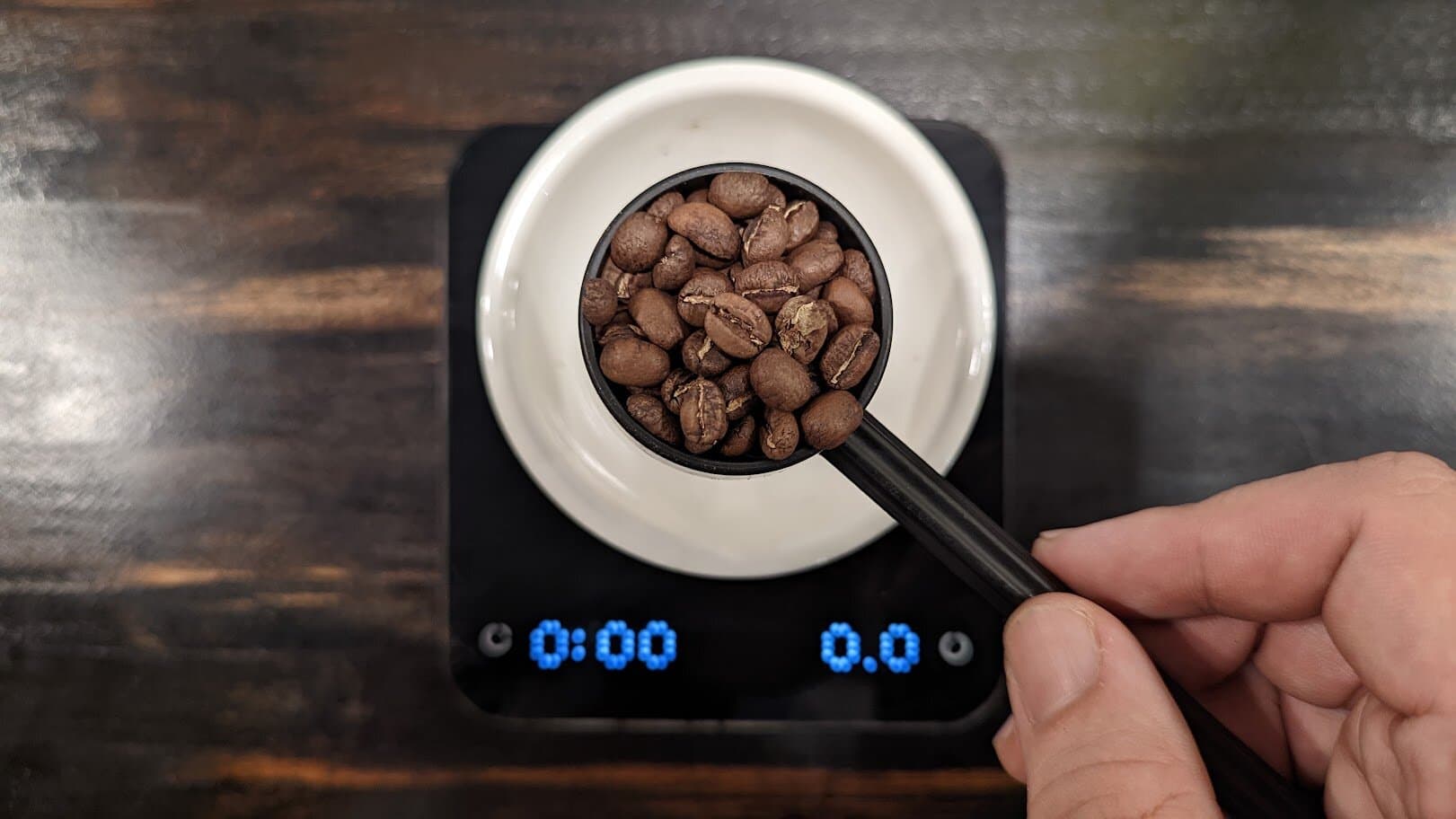 If you’re like me and you like an indestructible scoop with a lot of features, then you might enjoy adding this brewer’s measuring tool to your arsenal. It holds an average of 16.4 grams of light-roasted coffee in our testing, which normalizes to 10.1 grams of dark-roast coffee, or right around 2 tablespoons!
If you’re like me and you like an indestructible scoop with a lot of features, then you might enjoy adding this brewer’s measuring tool to your arsenal. It holds an average of 16.4 grams of light-roasted coffee in our testing, which normalizes to 10.1 grams of dark-roast coffee, or right around 2 tablespoons!
This makes sense for a brewer that’s popularly used to brew medium and light-roasted coffee, typically with recipes ranging from 13 to 17 grams.
1-Cup Pourover Scoop
 I picked up this metal scoop from a Korean coffee supplier, thinking its durability would serve me well. But it gets very little coffee in it, so I don’t use it often.
I picked up this metal scoop from a Korean coffee supplier, thinking its durability would serve me well. But it gets very little coffee in it, so I don’t use it often.
Despite its heft, this 1-cup scoop averaged 12.1 grams of a light roast in our testing — perfect for a 1:15 ratio on a full-immersion brewer! For dark roasts, this means around 8 grams of coffee or 1.6 tablespoons.
Wilfa Svart Auto Drip Scoop
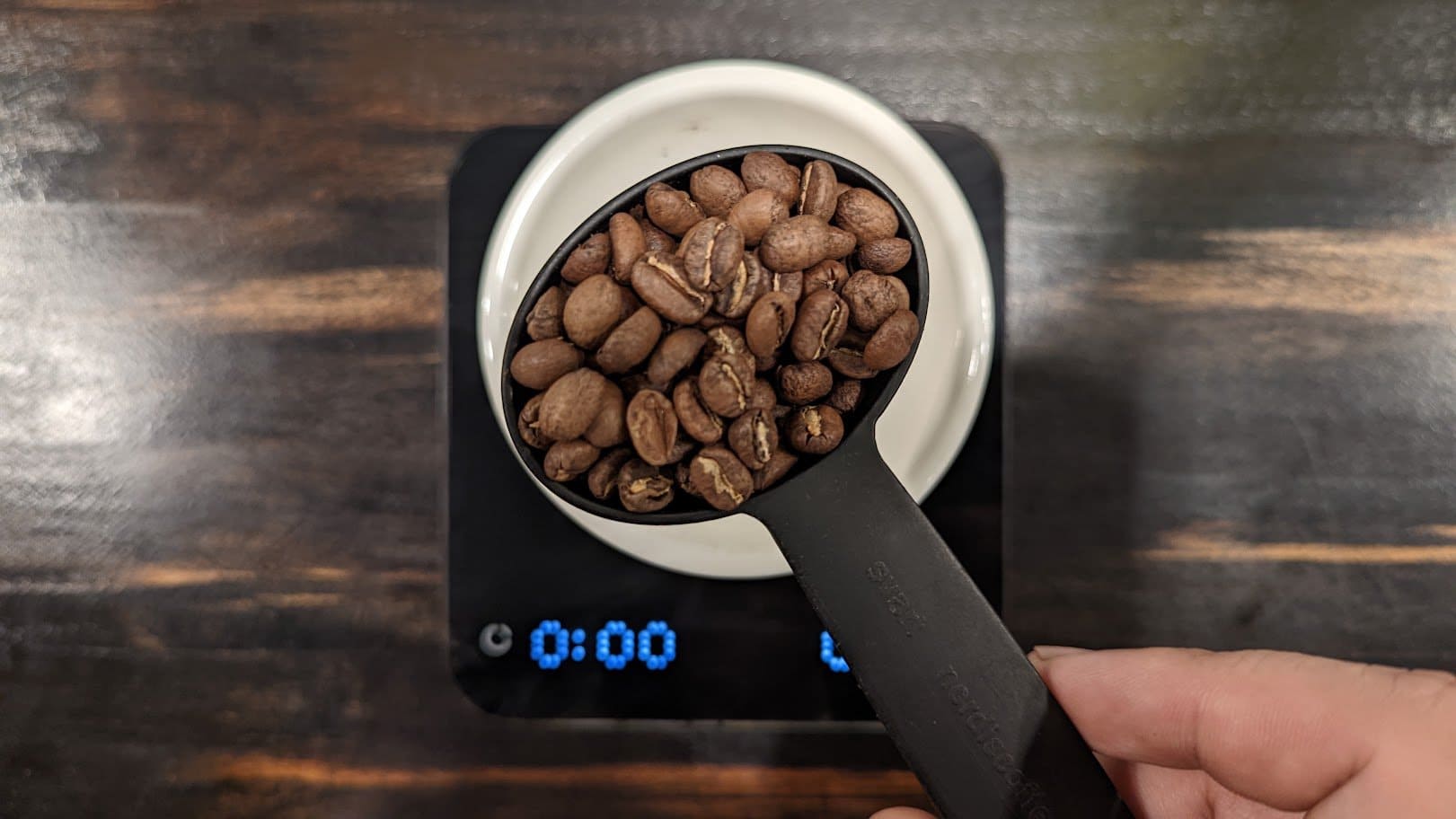 I decided to include this comically-large scoop to see how much coffee it could weigh out. 19.8 grams of a light roast! This is pretty close to Wilfa’s recommended 17g of coffee per 250ml liter. This equates to about 13g of a dark roast or 2.6 tablespoons.
I decided to include this comically-large scoop to see how much coffee it could weigh out. 19.8 grams of a light roast! This is pretty close to Wilfa’s recommended 17g of coffee per 250ml liter. This equates to about 13g of a dark roast or 2.6 tablespoons.
2-cup Pourover Scoop
 This came included with my CAFEC 02 dripper, but you’ll find similar scoops included with Hario V60s.
This came included with my CAFEC 02 dripper, but you’ll find similar scoops included with Hario V60s.
It seems that they don’t make scoops larger than these, so sub-20 grams is as good as it gets! This is very close to the 1:16:67 ratio of my coffee shop’s recipe of 20 grams of coffee and 333 grams of water (for a 10oz cup).
Similar to the Wilfa, you get 13g if you scoop up a dark roast, which is also equal to 2.6 tablespoons.
Dinner Spoon
 If all you have available to you is cutlery, then you might consider going for the largest option available. Our spoon scooped up 11g of light-roast coffee, which is equal to 7.3g of a dark roast, or 1.4 tablespoons.
If all you have available to you is cutlery, then you might consider going for the largest option available. Our spoon scooped up 11g of light-roast coffee, which is equal to 7.3g of a dark roast, or 1.4 tablespoons.
Standard Tablespoon
While a scoop size may vary from one brand to the next, a standard tablespoon measuring scoop should be the same across the board.
Not Sure What Your Scoop Is?
We’ve offered you a bit more precision if your scoop is close to the ones I tested above. But if you’re still not sure? Just stick to the generally-accepted conversion of two tablespoons per scoop.
Just for fun, I averaged out the values of our six scoops and ended up with 2.05 tablespoons. So it’s a pretty solid guesstimate!
Anyway, here’s a handy guide:
| What Scoop Are You Using? | Equivalent Tablespoons |
| 1-cup pour over scoop | 1.6 |
| 2-cup pour over scoop | 2.6 |
| Aeropress Scoop | 2.1 |
| Large Dinner Spoon | 1.4 |
| Not Sure | 2 |
Frequently Asked Questions
What is the Golden Ratio of Coffee?
The Golden Ratio, also called Golden Cup Standard, is defined by the National Coffee Association and the Specialty Coffee Association as two tablespoons (or 10 grams) of ground coffee for every six fluid ounces (or 180ml) of brewing water.
This is based on the Coffee Brewing Control Chart, which specifies a balanced cup of coffee having a ratio of 55 grams of coffee per liter of brewing water, or simply 55g/L. Simplified even further, we get 1:18.
While useful for maximizing the extraction of flavors, such as the goal in a coffee cupping or tasting, intensity is often lacking.
Do Coffee Pots Measure Cups or Ounces?
Most American coffeemakers will use either, but each cup marking on the brewer or server will default to 5 fluid ounces. If you happen to have a Japanese pot, you will see a much smaller conversion of 4 fluid ounces per cup.
How Can I Dose Coffee Without a Scale?
The best and most accurate way to measure coffee is with a scale. But in the absence of that, use a tablespoon or similar volumetric measurement tool, and use our calculator for a recipe you can decipher!
How Can I Dose Coffee Without a Scoop?
If you have one, you can use a large dinner spoon, which is roughly equivalent to 1.4 tbsp. You can also approximately split up your coffee bag if brewing bigger servings. For instance, use a quarter of a typical 8oz bag (which is 2 dry ounces) to make 5 cups of a regular-strength auto-drip.
Brewing Cheat Sheets
Still confused? Scales, spoons, and scoops can be utterly confusing, and I don’t blame you.
Here’s a cheat sheet for frequent coffee serving sizes, featuring common measurement units.
Note the differences in coffee to water ratio of drip/percolation versus full-immersion methods.
How Many Scoops For One Cup of Coffee?
How Many Scoops For 2 Cups of coffee?
How Many Scoops For 4 Cups of coffee?

How Many Scoops For 5 Cups of Coffee?

How many Scoops For 8 Cups of coffee?
How many scoops for 10 Cups of coffee?
how many scoops for 12 Cups of coffee?

To Sum It All Up
It’s important to remember that these recipes should merely function as a guide and that you should always let your taste be the arbiter.
For consistent brews, there’s nothing quite like a scale. But in the absence of one, knowledge of volumetric conversions can be a lifesaver.


